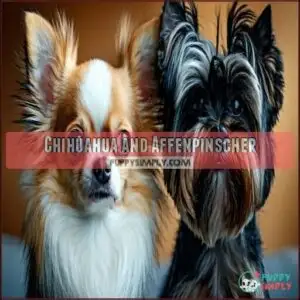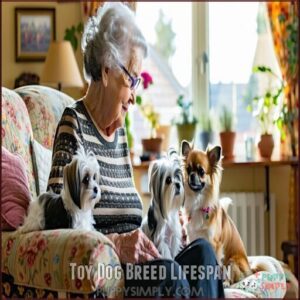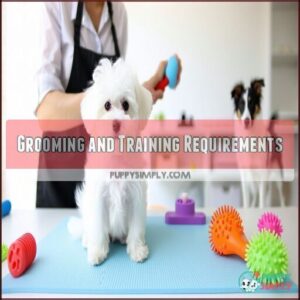This site is supported by our readers. We may earn a commission, at no cost to you, if you purchase through links.
 Toy dog breeds typically weigh under 15 pounds and stand less than 12 inches tall.
Toy dog breeds typically weigh under 15 pounds and stand less than 12 inches tall.
You’ll find popular options like Chihuahuas, Yorkshire Terriers, Pomeranians, and Maltese that pack big personalities into small packages. These pint-sized pups make ideal companions for apartment dwellers or those with limited mobility.
Despite their diminutive stature, many toy breeds live 12-15 years and require regular dental care to prevent common health issues.
They’re not just adorable lap warmers—these clever canines need mental stimulation and proper training just like larger dogs.
The right toy breed might be small enough for your purse but substantial enough to change your life.
Table Of Contents
- Key Takeaways
- Toy Dog Breed Overview
- Popular Toy Dog Breeds
- Toy Breed Health Considerations
- Toy Dog Breed Lifespan
- Caring for Toy Breeds
- Frequently Asked Questions (FAQs)
- What are the best toy dog breeds?
- What is a toy dog?
- Why are toy dogs so popular?
- What are the different types of toy dogs?
- How many toy dog breeds are there?
- What is a toy dog breed?
- What dog breeds come in toy size?
- Which toy dog is the best?
- Which dog breed looks like a toy?
- What is the friendliest tiny dog?
- Conclusion
Key Takeaways
- Toy dog breeds weigh under 15 pounds and stand less than 12 inches tall, making them ideal companions for apartment living and people with limited mobility.
- Despite their small size, toy breeds typically enjoy longer lifespans (12-16 years) than larger dogs, though they require vigilant health monitoring for issues like dental problems, hypoglycemia, and patellar luxation.
- You’ll need to adapt your care routine with small, frequent meals (3-4 daily), appropriate exercise (15-45 minutes depending on breed energy level), and consistent grooming to keep your toy breed healthy.
- These pocket-sized companions pack big personalities and need proper training and mental stimulation just like larger dogs, making them substantial additions to your life despite their diminutive stature.
Toy Dog Breed Overview
You’ll find toy dog breeds typically weigh under 15 pounds and were specifically bred for companionship rather than working roles.
These compact canines come in various appearances and temperaments, from the spirited Chihuahua to the affectionate Maltese, making them ideal pets for apartment living and families seeking portable, loving companions.
Pocket-sized personalities and boundless love make toy breeds perfect companions for modern living.
Characteristics of Toy Breeds
You’ll find toy dog breeds share distinctive characteristics beyond their small size.
Typically weighing under 15 pounds, these companion dogs pack big personalities into tiny frames.
They’re known for their affectionate nature and adaptability to apartment living.
Breed temperament varies widely – from spunky Chihuahuas to mellow Maltese – but most crave human connection. Their portable size makes them perfect travel buddies, though their big-dog attitudes might surprise you!
History and Origins
Toy dog breeds emerged from centuries of careful breed development, with ancient ancestors dating back to Egyptian and Chinese civilizations.
Tiny dogs with massive history—royalty’s chosen companions since ancient times, bred smaller over centuries.
Your tiny companion likely has royal connections—many were bred specifically for nobility and royal courts.
Breed standardization happened primarily in the 19th century, though regional variations existed earlier.
These pint-sized pups evolved from larger working dogs, selectively bred over generations to achieve their adorable diminutive stature.
The Toy Australian Shepherd exemplifies this trend, developed from smaller Miniature Australian Shepherds.
Size and Weight Variations
Variation in size defines the toy dog category, with breed standards establishing specific parameters for these pint-sized companions.
You’ll find significant differences even within this petite classification:
- Most toy breeds weigh between 4-14 pounds when fully grown
- Height typically ranges from 6-12 inches at the shoulder
- Teacup varieties often weigh under 4 pounds
- Genetic influence determines growth stages and final size
- Weight fluctuations of 1-2 pounds can be significant in miniature dog breeds
Popular Toy Dog Breeds
You’ll find Chihuahuas, Pugs, and Yorkshire Terriers among the most sought-after toy breeds for their adaptability to apartment living and travel-friendly size.
These companion-focused breeds offer distinctive personalities and characteristics, from the bold confidence of the Chihuahua to the affectionate nature of the Maltese.
Chihuahua and Affenpinscher
Despite their small stature, Chihuahuas and Affenpinschers pack big personalities into tiny frames.
Chihuahuas, originating from Mexico, are confident and devoted companions weighing just 2-6 pounds, while the monkey-faced Affenpinschers from Germany bring fearless charm at 7-10 pounds.
Both toy dog breeds require minimal exercise but differ in grooming needs—Chihuahuas need occasional brushing, whereas Affenpinschers’ wiry coats demand regular maintenance.
Pug and Maltese
Pugs and Maltese stand at opposite ends of the toy breed spectrum.
Your Pug brings playful temperament and expressive wrinkles, requiring minimal grooming but needing weight management. Maltese, with their silky white coats, demand daily brushing but offer elegant companionship.
Both small dog breeds make excellent apartment companions, though they differ in exercise needs—Pugs prefer short walks while Maltese enjoy indoor play sessions.
Owners should also be aware of common toy breed health concerns.
Yorkshire Terrier and Poodle
These two beloved toy dog breeds pack a powerful punch in small packages. Yorkshire Terriers bring feisty bravery while Poodles contribute intelligence and hypoallergenic coats. Their hybrid offspring, Yorkie-Poos, combine the best qualities of both.
- Yorkshire Terriers will capture your heart with their bold personalities despite weighing under 7 pounds
- Toy Poodles excel in training with their remarkable intelligence and adaptability
- Yorkie-Poo hybrids offer the perfect balance of affection and playfulness without excessive shedding
Toy Breed Health Considerations
You’ll need to monitor your toy breed’s health closely as their small size makes them prone to specific issues like dental problems, hypoglycemia, and joint conditions.
Regular veterinary check-ups and proper dental care will help your tiny companion live a longer, healthier life. Regular veterinary check-ups and proper dental care will help your tiny companion live a longer, healthier life.
Common Health Issues
Many toy dog breeds come with genetic predispositions to specific health issues that require vigilant veterinary care.
Understanding these conditions helps extend breed lifespan and reduces emergency care costs.
Maintaining good oral hygiene is imperative, so consider dog dental care options.
| Health Issue | Prevention Tips |
|---|---|
| Dental Disease | Daily brushing prevents serious complications |
| Tracheal Collapse | Use harnesses instead of collars |
| Mitral Valve Disease | Schedule regular heart checkups |
| IVDD | Maintain healthy weight, limit jumping |
| Temperature Regulation | Monitor for overheating/chilling |
Hypoglycemia and Patellar Luxation
Among the health issues affecting your tiny companion, hypoglycemia and patellar luxation need special attention.
These conditions have strong breed predispositions in toy dog breeds.
Patellar luxation involves the kneecap moving out of its normal location.
- Low blood sugar can cause weakness—keep Karo syrup handy for emergencies
- Joint dislocation occurs when kneecaps slip out of place
- Mild cases may need only rest and anti-inflammatories
- Surgical options exist for more severe orthopedic issues
- Preventative measures include maintaining healthy weight and joint supplements
Dental Care and Regular Check-ups
While hypoglycemia and patellar luxation demand attention, your toy dog’s tiny mouth needs equal care.
Toy dog breeds often face dental problems like tartar buildup and gum disease due to their crowded teeth.
Start teeth brushing when they’re still in the puppy teeth stage. Schedule professional cleaning annually, and provide tartar control treats between check-ups.
Consider using a specialized toothbrush designed for smaller breeds. Your pocket-sized pooch will thank you with fresher kisses!
Toy Dog Breed Lifespan
You’ll find that toy breeds typically enjoy longer lifespans than their larger counterparts, with many living well into their teens.
Your tiny companion’s longevity depends on factors like genetics, diet, exercise, and regular veterinary care.
Making these pocket-sized pups not just adorable additions to your home but potentially long-term family members.
Factors Influencing Longevity
While toy dog breeds often have impressive lifespans, several key factors can either extend or diminish their years with you.
Understanding what influences your small companion’s longevity helps provide the best care possible.
- Genetics play a significant role in determining your toy breed’s potential lifespan
- Nutrition quality directly impacts organ function and overall health
- Regular exercise prevents obesity while strengthening heart health
- Preventative care catches issues before they become serious
- Environmental factors like stress levels and air quality affect daily well-being
Average Lifespan of Toy Breeds
Pint-sized longevity champions, toy dog breeds typically enjoy life spans of 12-16 years, outpacing their larger cousins by several years.
You’ll find genetic predisposition plays a significant role in dog breed lifespan, while diet impact and exercise influence can add quality years.
With proper preventative care and favorable environmental factors, these pocket-sized companions often celebrate more birthdays, making them ideal long-term family members.
Breeds With Longest and Shortest Lifespans
Over the years, you’ll find striking differences in dog longevity between toy breeds.
Chihuahuas often reach 18-20 years, with Toy Poodles (10-18 years) and Papillons (14-16 years) also enjoying extended lifespans.
In contrast, flat-faced breeds face genetic predispositions to shorter lives—French Bulldogs average just 4.53 years, while Pugs live about 7.65 years.
These breed-specific ailments highlight why prime care strategies are fundamental for dog health. Understanding the needs of popular toy dog breeds can greatly impact their well-being and lifespan.
Caring for Toy Breeds
You’ll need to adapt your care routine for toy breeds due to their small size and specific health needs.
Their tiny bodies require carefully portioned meals, gentle exercise options, and special attention to dental health to guarantee they thrive as your compact companion.
Nutrition and Diet Requirements
After extending their lives with proper care, feeding your tiny companions correctly becomes your next priority.
These small dogs have unique nutrition needs:
- Their tiny tummies need small, frequent meals (3-4 daily)
- Their metabolism burns like a furnace (40 calories/pound vs.
22.5 for larger breeds)
- Their growth requires protein-packed diets (minimum 22.5% for puppies)
- Their health depends on vitamins C, E, and L-carnitine
Exercise and Mental Stimulation Needs
While your tiny companion may not need marathon sessions, toy dog breeds still require proper exercise and mental stimulation to stay healthy and happy.
Their small size doesn’t diminish their need for activity.
| Breed Type | Daily Exercise | Mental Stimulation |
|---|---|---|
| High Energy (Yorkies) | 30-45 minutes | Puzzle toys, training games |
| Medium Energy (Pugs) | 20-30 minutes | Socialization, fetch games |
| Low Energy (Pekingese) | 15-20 minutes | Gentle play, indoor activities |
Chihuahuas, for example, benefit from at least 30 minutes daily of combined activity.
Don’t underestimate your pint-sized pup’s playfulness!
Match activities to their specific energy levels for a content, well-balanced pet.
Grooming and Training Requirements
Most toy dog breeds require specific grooming and training approaches to thrive. Despite their size, they need consistent guidance and proper coat care.
For prime coat maintenance, consider using a specialized grooming tool.
- Brush short-coated breeds weekly and long-coated varieties daily to prevent mats
- Schedule professional grooming every 4-6 weeks for breeds with continuous hair growth
- Begin obedience training early using positive reinforcement techniques
- Prioritize socialization with people and other dogs before 16 weeks
- Implement mental stimulation through puzzle toys and short training sessions daily
Frequently Asked Questions (FAQs)
What are the best toy dog breeds?
Precious pups like Papillons, Maltese, and Yorkies make magnificent companions for your home.
You’ll love their loyal personalities, portable size, and adaptability to apartment living—they’re perfect pocket-sized pets with plenty of personality.
What is a toy dog?
A small canine companion that weighs under 15 pounds, bred specifically for companionship rather than working purposes.
You’ll find they’re perfect for apartment living and often have big personalities despite their diminutive size.
Why are toy dogs so popular?
These pocket-sized companions are popular because you’ll enjoy their portability in apartments and busy lifestyles. They’re affectionate, form strong bonds, require less exercise, and live longer than larger breeds.
What are the different types of toy dogs?
You’ll find numerous toy breeds including Chihuahuas, Yorkshire Terriers, Pugs, Maltese, Affenpinschers, Toy Poodles, Papillons, Shih Tzus, and Pomeranians. They’re bred specifically for companionship rather than working abilities.
How many toy dog breeds are there?
You’ll fall in love with toy dogs!
Currently, there are about 25-30 recognized toy dog breeds worldwide, though exact numbers vary by kennel club.
They’re perfect companions if you’re living in smaller spaces.
What is a toy dog breed?
Toy dog breeds are companion canines weighing under 15 pounds, bred specifically for their small size.
You’ll find they’re affectionate, portable pets that adapt well to apartment living and make excellent lap companions.
What dog breeds come in toy size?
Like tiny treasures on a chain, you’ll find Chihuahuas, Yorkshire Terriers, Maltese, Pomeranians, Toy Poodles, Shih Tzus, Pugs, Papillons, and Cavalier King Charles Spaniels all classified as toy breeds under 15 pounds.
Which toy dog is the best?
The "best" toy dog depends on your lifestyle.
You’ll connect with breeds like Cavaliers for gentleness, Yorkies for spunk, or Maltese for affection.
Consider your space, time, and personality when choosing.
Which dog breed looks like a toy?
Many breeds resemble toys due to their petite size and plush appearance. You’ll find Pomeranians, Shih Tzus, and Maltese particularly stuffed-animal-like with their fluffy coats and button eyes.
What is the friendliest tiny dog?
The Cavalier King Charles Spaniel stands out as the friendliest tiny dog.
You’ll love their gentle nature, constant affection, and willingness to please.
They’re adaptable companions who get along with everyone they meet.
Conclusion
With over 23 million American households owning toy dog breeds, these diminutive companions continue to captivate hearts nationwide.
Whether you choose a spirited Chihuahua or an elegant Maltese, you’ll find these small dogs offer outsized devotion and personality.
Despite their size, toy dog breeds require thoughtful care regarding dental health, proper nutrition, and mental stimulation.
By understanding their unique needs, you’ll enjoy many years with your pint-sized companion—proving that sometimes the biggest love comes in the smallest packages.















